French vineyards
Above the volcano
This article was originally published during Fall 2017 in R&B n°126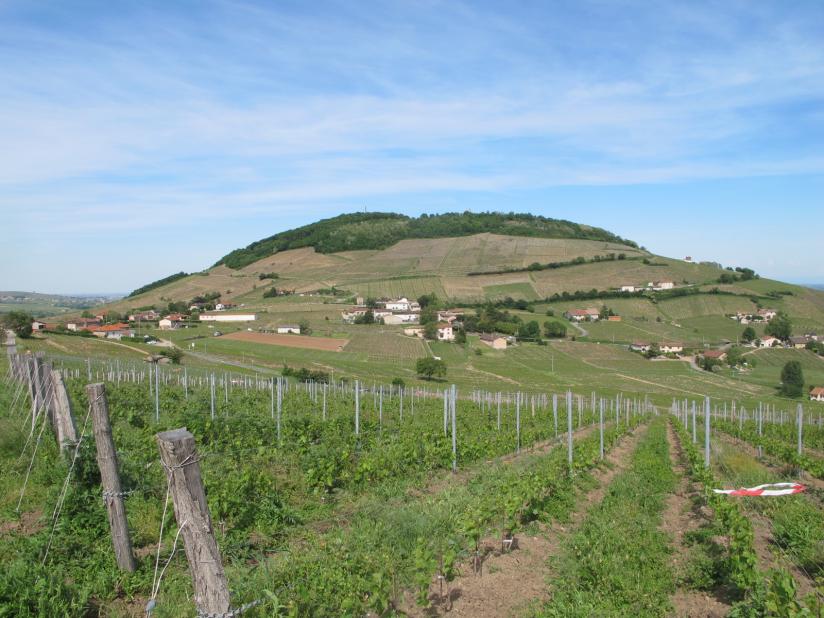
BOURGOGNE > BEAUJOLAIS > CÔTE-DE-BROUILLY
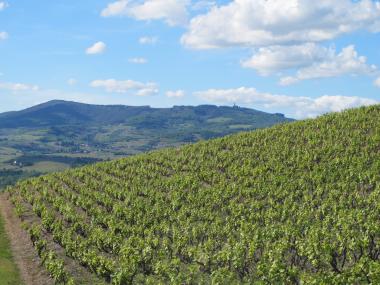
The paradox is only apparent. Unlike real volcanoes, the emergence of Mount Brouilly was not caused by an eruption of lava propelled above ground level, nor by an uprising of the ground. It is, conversely, constituted by an underground mass of magma remained locked in the bowels of a volcano much more imposing than the current hill, about 380 million years ago. In the belly of the extinct volcano, the cooled magma then crystallized into a very hard blue-green rock, called "diorite", aka "blue stone". Annealed a few million years later by an incandescent granite bubble, part of this mass of rock has been enriched with additional shades of green that is sometimes called "green horn".
Much later, 35 million years before our era, the collapse of the plain of Bresse, completed by the raising of its borders, gave birth to the mountains of Beaujolais, dominated by the mount Saint-Rigaud (1009 m), and to the hill of Brouilly. The diorite then emerged from its gangue over erosion, as a bell comes out of its broken mold with small hammer hits. Today, the wooded summit culminates at 484 m and is adorned with the chapel Notre-Dame-aux-Raisins, built in the hope (vain) to protect the vineyard from the dangers of powdery mildew, frost and hail that had ravaged it in 1850 and 1852.
High place of Beaujolais, as well as Côte du Py in Villié-Morgon, Mount Brouilly is not, however, a summit of the vine altitude; it is even taken high in the region by Chiroubles, Fleurie and Regnié where some plots are cultivated above 500 m. On the mount, the average altitude of the vine cultivation is "only" 350 m, but it can be flattered to be covered with vine from head to toe, except for the top forest place, as well as on almost all of its flanks.
Le Mont-Saint-Michel of the vines
This situation and this geological origin give to the Côte-de-Brouilly peculiarities which reflect on its wines: the high proportion in its underground of magmatic rocks (also present in ViIlié-Morgon, on the Côte du Py and in the sector of Javernières) ; the nearly equal proportions of vines enjoying each of the four exposures to the sun; and the slopes that sometimes make viticulture difficult (this is the second highest sloping growth on average in Beaujolais, after Chiroubles, with 50% slopes above 15% and very little less than 5%).
The "blue stones", more or less degraded, more or less annealed, constitute two-thirds of the subsoil, leaving only 24% of the surfaces with granite, classic base of AOC Beaujolais, confined to the western flank of the hill .
The differences between these two types of soils are not negligible. Covered with very dark pebbles, fragments of diorite or shale, the soils of blue stone are better protected from thunderstorms and have a better capacity of absorption of the rains, which limits their erosion. Unlike granite, these stones, which are not very siliceous, do not disintegrate into sand; they produce mostly clays for better water reserves. On the other hand, their pH is neutral whereas that of the granite soils is acidic on the surface. These soils are also richer in magnesium, but may have potassium deficiency. "Globally these are stony soils, fertile and stable, so very favorable for the vine," concludes a geological study conducted by the Sigales laboratory for the Rhône Chamber of Agriculture. After our tastings, we are convinced too. Even if the 2015 vintage, tasted by the LeRouge&leBlanc, very solar, pulled the wines to the south and sometimes to the south, most of the samples retained a good mineral pattern that avoided falling into softness and assured them a certain freshness.
A multifaceted wine
By schematizing, Côte-de-Brouilly produced on granitic soils have a brouilly side, easier, lighter, while those coming from the bluestone soils exhibit a structure and superior minerality. On closer inspection, there are also notable differences between two blue-stoned wines, one from the north of the mountain, which is cooler (often marked by liquorice aromas), and the other from the south, which is solar. is the earliest area of all Beaujolais. And if the winemaker is fortunate to have plots on different sides of the hill, he can play as a palette to build nuanced assemblages.
As in all viticultural regions, the other essential factor in the quality of wines is the practice of winemakers. No need to hide the face: Beaujolais is not the region of France where this practice is the most respectful of nature, no more on Côte-de-Brouilly than elsewhere. Many reasons, good or bad, "justify" the use of chemistry: the uncertain climate, particularly in recent years, and favorable to diseases; the importance of slopes; old vines cut in goblets and planted at 10,000 feet / ha, almost in a crowd, so difficult to work mechanically; and, to top it off, the decline in revenues due to the crisis experienced in recent years by the Beaujolais trading and cooperatives, which however often represent more than 60% of the volumes of the region (in Côte-de-Brouilly, the share of sales traders dropped from 62% to 47% between 2012 and 2016). Other bad habits, such as thermovinification, persist in places. To facilitate the tillage, there is also the temptation to lower the density, as allowed by the AOC decree (6000 feet / ha minimum), even if, under these conditions, the gamay can show a unfortunate tendency to productivity.
The oasis of the bad years
In this difficult context, Côte-de-Brouilly is not the Beaujolais appellation, which is doing the worst. Perhaps because its small size and small volumes make it less attractive for trading, its winemakers have always had to make efforts to sell their wines by themselves, more than elsewhere in the region. They thus aimed for a higher quality on average. Perhaps also because important areas, such as Château Thivin, have shown the right path for many years. Perhaps because the overall quality of the terroir guarantees the quality of the wines, even in difficult years. "All the complicated years, it's on the Côte de Brouilly that we're doing the best," says Christophe Pacalet who vinifies eight appellations of Beaujolais. These years, we see everything in black, but when we arrive at Mount Brouilly, it gives us a balm to the heart. This is one of the most beautiful terroirs for gamay. He gives wines always straight, saline. It would seem, therefore, that, of all the terroirs of Beaujolais, the coast is the one which assures the Gamay the best conditions of ripening and general good health.
An objective index confirms this hypothesis: the number of young winemakers from other terroirs in the region, or even Burgundy, who are struggling to find vines to exploit on Mount Brouilly or grapes to be vinified. Among these are, for example, winemakers already noticed by LeRouge&leBlanc: Rémi Dufaitre, France Gonzalvez or Claire and Fabien Chasselay. There is even since 2016 another name known in the region: Alex Foillard, son of one of the references of Morgon, Jean Foillard, now operates one hectare on the coast and one hectare at the foot of Mount AOC Brouilly. "I came to see the vines before buying them," says Jean. When I saw the terroir, I said yes right away. Even if Alex did not want it, I would have kept these plots for me! He is a connoisseur who speaks. Tasted just after bottling, the first vintage (2016) confirms the intuition of the buyer.
The AOC Côte-de-Brouilly in brief
- Date of creation: 19 October 1938
- Area: 319 ha, spread over the territory of four communes, Cercié, Odenas, Quincié-en-Beaujolais, Saint-Lager.
- Main grape variety: gamay.
- Grape varieties: aligoté, chardonnay and melon, only accepted as a mixture of plants in the vineyards in a proportion limited to 15% in each plot.
- Minimum density: 6000 feet / ha.
- Allowed pruning: short, Gobelet, éventail, single or double Royat cord, or "charmet" (éventail variant) with a maximum of ten eyes/buds per vine.
- Minimum title: 10,5 °.
- Basic yield: 56 hl / ha (buffer: 63 hl / ha).
- In 2016, 142 operators marketed Côtes-de-brouilly, of which 123 sell bottles (partially or entirely).
- Trading sales declined from 62% in 2012 to 47% in 2016.
The estates that we selected
The R&B regulars
Among the wines we have selected, there are those regulars of LeRouge&leBlanc, already distinguished in other articles: the estate of Botheland (Rémi Dufaitre), the Chasselay estate and the France Gonzalvez estate.
The last two named having been featured by articles in the previous issues of the magazine (R & B No. 125), and Rémi Dufaitre appearing in No. 117, devoted to white Beaujolais (where the domain Chasselay was already noticed), he seemed more judicious to visit other producers, less accustomed to our columns.
The fact remains that these three areas are on our honor roll, and that their Côtes-de-Brouilly are at the height of their other wines.
Each of the three shows a style of his own: drinkability for Rémi Dufaitre, the structure for Chasselay or matter for France Gonzalvez, but they all caught the attention of our tasters and deserve the interest of readers.
Rémi Dufaitre operates 2.8 ha (property and farming) spread over the north and south of Mount Brouilly. He practices a carbonic vinification and tries to extract as little as possible. The wines are bottled without sulfur or with 10 mg / l when the need arises.
Until last year the Chasselay bought grapes from their Côte-de-Brouilly, but they acquired a plot of 31 acres, Chardignon, located in Saint-Lager on the north-east side of the mountain, which will go into production in 2017 and which is located on a deep floor of degraded blue stones.
France Gonzalvez also buys the grapes she vinifies in whole bunches, Beaujolais style, with just a mini dose of SO2 bottling after an aging which, for the coast of Brouilly 2015, took place totally in barrels, whereas in more normal vintages, under wood ageing is only partial. "
The estates that we visited
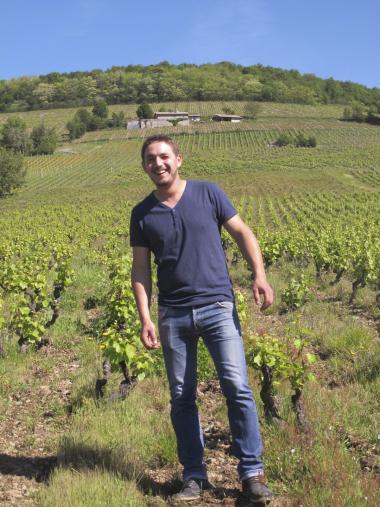
Pierre Cotton
To find the Sanvers and Cotton property, you have to head south. There, on the southern slopes of Mount Brouilly, its 5 ha of Côte-de-Brouilly (on a total of 10 ha) extend on a ground of "green horn", a diorite annealed by the emergence of a bubble of incandescent granite and which contains a little more silica than the usual "blue stones".
The exploitation is now led by the young Pierre Cotton who has definitely taken over from his father, who retired in 2017. Initially a motorcycle mechanic, Pierre returned to the vineyard, after a BTS viti-ono and various internships, for take over the four generations that preceded it. Since 2014 his father gave him a plot of Côte-de-Brouilly to vinify; experience renewed in 2015 (the wine we enjoyed during our tastings); then, in 2016, Pierre vinified the entire estate before taking the lead this year.
While his father used "starter" yeasts, bruised and filtered before bottling, the young winemaker took advantage of indigenous yeasts, minimal SO2 (10 mg / l maximum) and non-filtration. "The idea came to me when I talked to other winemakers like Sébastien Riffault in Sancerre, where I worked," he explains, "and with the friends of the" youth gang ": Jules Métras, Yann Bertrand, Alex Foillard, Kevin Descombes, Damien Coquelet, Anthony Thevenet, or Rémi Dufaitre; we are often together. In addition, the best sips that I had, it was wines of Lapierre, Foillard, Breton ... It made me a little click. "
To know whether to put a little sulfur or not, Pierre makes "air exposure" tests: "I place full glasses in different places: in the sun, in the fridge, everywhere, and then I tastes from day to day. If it does not move in glasses, there is no risk in the bottle. "
In the vineyards, his father had stopped chemistry since the early 2000s, even if the gobelet pruned vines at 10,000 feet / ha make it difficult to tillage: "In the vines that are replanted," explains it, we will keep the same density, because at the qualitative level it is important, but we will train them in candlestick. The AB accreditation (organic) will take place in 2018.
The harvest is entered in whole bunches. A sorting in the vineyard is followed by a second, on the table. The tanks are saturated with carbon dioxide (CO2). The press is pneumatic. The ageing is done in "old" wood containers, barrels or foudres. "We are not trying to extract," says Pierre Cotton. We aim more finesse than the big black stain in the glass. The goal of the game is to make drinkable sips. "
Successful bet. The estate produces eight cuvées, including a white Beaujolais, from the Regnié and two cuvées from Côte-de-Brouilly (the wine tasted in 2015 was just the beginning of the adventure and was marketed under its name). All of a beautiful frankness and a beautiful natural.
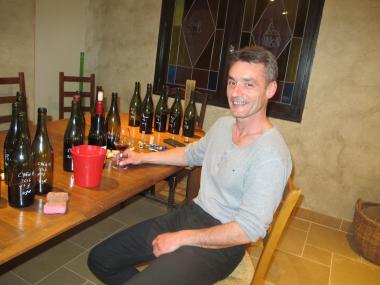
In terms of wine, Stéphane Aviron has some experience. For 40 years, his father was an oenologist and a broker in the Beaujolais, and he himself worked as a bottler, in addition to being a trader. Beaujolais, so he knows it from top to bottom, even in his back cellars.
Associated with a Burgundian trader, Nicolas Potel, he has used his knowledge of the ground for seventeen years to find good producers: "We do not buy grapes, I do not have the material for. We vinify in the vats of the producers with whom we work. For example, my Côte-de-Brouilly comes from the vineyards of a winegrower from Odenas, with whom my father was already working. Its vines, 45 years old, are very steep. I vinify, and then I choose my wines. "
The viticulture of its suppliers is reasoned. Stéphane Aviron vinifies in whole bunches; it tries to avoid yeasting, except years of low acidity like 2015. The fermentations are rather short, "to avoid maceration in alcohol and vegetal tastes". The wine is sulfured, at the harvest and after the malolactic fermentation, for a total of 40 mg / l. The aging of the coast-de-brouilly is done by half in barrels of 5 to 8 years, and by half in stainless steel tanks.
In addition to the Côte-de-Brouilly, the estate produces brouilly, chénas and fleurie. "I try to make soft wines, says Stéphane Aviron, because by experience I know that wines that have to refine with time never get finer ..." The result is more than honorable, and the prices very wise .
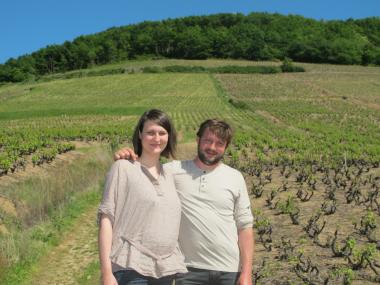
Domaine Léonis (Raphael and Cristelle Champier)
Although he is very young, his colleagues respect and appreciate the "Little Raphael", as they say. He made his experience with good winemakers in the region, like Jean-Claude Lapalu, not particularly known for handling chemistry. Coming from a family of winemakers, he started in 2009 with 64 ares of Beaujolais-Villages. In 2011, he settled on 7.5 ha of vines: 1.2 ha of Côte de Brouilly, 86 ares of Brouilly and the rest in Beaujolais-Villages.
His parcels of Côte de Brouilly, on the south-west of the Mount, look at Quincié. At the bottom of the hill are granite gores and, at the top, clays where diorite is visible. In places, there is only 2 or 3 cm of soil. "I plow as little as possible, at most four times a year, and shallow, so as not to smother the soil. I intend to buy light agricultural equipment not to pack them, "says the winemaker. The vines, 90 to 100 years old, are little prone to diseases thanks to the wind, very present. Since 2017, a flock of sheep has mowed the grass.
The harvest in whole bunches arrives in vats and the fermentation starts with the natural yeasts. "I taste the juice every day," says Raphael. The vatting, according to the vintages, lasts from ten days to three weeks, punctuated with pumping over if the need arises. For the Mont Brulius wine (Brulius, a lieutenant of the Roman armies, would have given its name to Mount Brouilly), the aging lasts seven months enameled tank "which creates less magnetic fields than stainless steel tanks". For the Cuvée N ° 2, the wine is aged 14 to 18 months in barrels or old casks. The total SO2 does not exceed 18 mg / l. We are dealing with dense wines, fresh, slender and persistent, with final on red fruits such as raspberry.
The two lovebirds, Raphael and Cristelle "eat their eyes" each other. He listens with passion Cristelle, who studied at the Beaux-Arts, describe wines that she could draw (a good idea to replace the notes!), And she looks, admiring, his Raphael who has so much talent. They can only offer nice wines, balanced and refreshing.
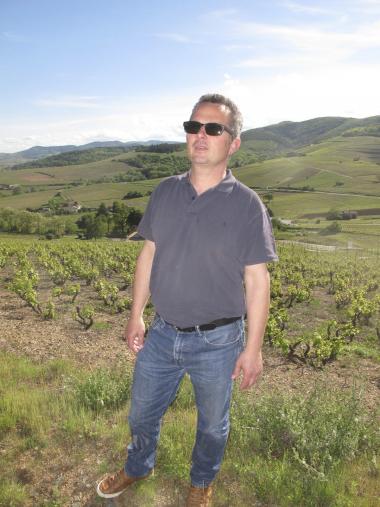
"You know, in the beginning, at the bistro, I did not dare to say that I was a trader. I was ashamed. And yet now everyone has become so. "The voice is soft, precise speech, like the wines of the house: when he talks about his debut in the profession, Christophe Pacalet, expresses a form of spite, not quite erased nearly twenty years later. In a country of winegrowers, selling wine without owning a vineyard was not well seen. "And yet we are passionate about wine," he sighs.
And yet, the wine, Christophe Pacalet is "born in". He is the nephew of Marcel Lapierre and the cousin of Philippe Pacalet, winemaker of Burgundy excellence: "My grandmother, my mother, Marcel and I lived around the same court. "
Marcel Lapierre, seventeen years older, became the mentor of the young Christophe when the latter, after several years of practice as a cook in the West Indies, decided to return home and get into the wine. "I wanted to buy vines, Marcel said to me: we will do as in Champagne; The Champenois are smart; we will buy grapes. It was in 1999. He helped me to vinify the first years, and he put my foot down commercially. It helps ! "
Over the years, Christophe's philosophy has evolved. He now buys the grapes from the same parcels every year from the same winemakers: "To have continuity. I am not trying to buy elsewhere, even in the case of disaster like hail at Fleurie last year. His specifications are very simple: "Old vines, beautiful grapes, treated as little as possible. He follows the work of the vineyard and ensures the harvest. The morning harvest is stewed directly, that of the afternoon is stored overnight at 14 ° in cold room not to "give a blow in advance" to the bad yeasts.
The vinification is done in whole bunches, with native yeasts in wood or resin vats. Wooden press, and vertical. Little extraction, little remuage. An aging in casks or barrels, according to the appellations (Christophe Pacalet vinifies eight). The Côte-de-Brouilly normally ages in foudres (big casks), except in 2015, vintage overpowering. Sulfur is banned in winemaking, not at stake, after a very light filtering. The dose varies between ... nothing (Saint-Amour 2016) and 35 mg / l (Côte-de-Brouilly 2015).
The philosophy of Christophe Pacalet is simple: "I like to please, like a cook who looks through the hatch if the customers at the table are happy. He likes "happy and silky" wines, an expression that is perfect for the entire production.
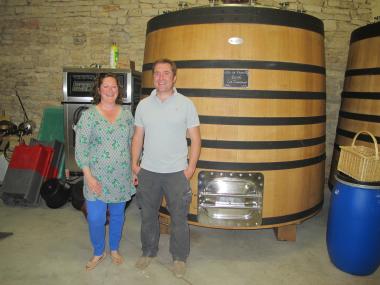
Based in Chassagne-Montrachet, children of a sancerrois father, Jean-Marc Blain, and a Burgundian mother, Claudine, who are at the head of the Blain-Gagnard estate, Marc-Antonin Blain and his sister Lucie were attracted by the potential of the terroirs of Beaujolais. In 2013 and 2014, they acquired 5.65 ha of Côte de Brouilly, divided into two plots exposed to the north and whose vines were planted in mass selection in the 1950s. They produce two cuvées: Pierre Bleue, and les Jumeaux (the Twins).
The gamay is pruned in gobelet, but Marc-Antonin wants to pick them up and go from a density of 10,000 feet / ha to 8,000 feet / ha to better aerate the vine and control its vigor. "They are worked inter-plant and grass between the rows with bluegrass that holds the soil well and does not pump too much water," says the winemaker. The growth of grass is controlled by the use of a top killer product (which destroys or devitalizes the tops of a crop before harvesting). Yields range from 40 to 45 hl / ha. On the spot, a person of trust treats and prunes the vine.
At the time of the harvest, Lucie directs the pickers and supervises the sorting table. The grapes are transported in a refrigerated semi-trailer to Chassagne-Montrachet where Marc-Antonin incubates them.
Chilled below 15 °, the grapes ferment in whole bunches. In 2015, the musts were 14 ° nature, the alcoholic fermentation, from the indigenous yeasts, lasted 15 days and the malolactic fermentation was triggered under the marc. The aging lasts about one year, in 40 hl wooden or concrete vats. The winemaker sulphites little: 20 mg / l of total sulfur in the end.
The vintage Pierre Bleue comes out, as its name indicates, of a plot with the soil of volcanic origin. It gives a wine austere in its youth, mineral, with a beautiful tannic structure "a little in the style of red huntings, "said the winemaker. He can wait 4 or 5 years. The cuvée Les Jumeaux (The Twins) comes from two adjacent plots on a rather clayey soil. The wine seems easier to access, juicy and fruity. Nevertheless, the wines of the Blain are the most Burgundy wines of côtes-de-brouilly.
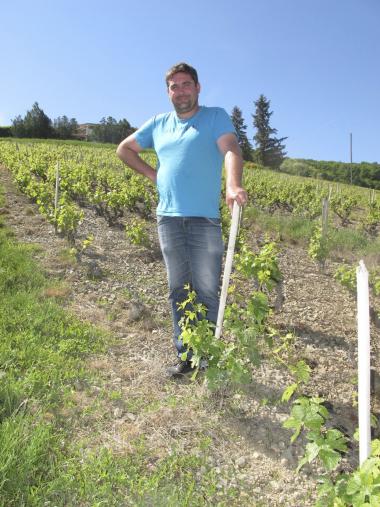
Domaine Joncy
From the estate at Quincié, you can admire the western face of Mount Brouilly in all its splendor. Sixth generation Beaujolais winemakers (on Quincié, Lantigné and Beaujeu), Guillaume Joncy, agricultural BEP in hand, took over from his father in 2003. The latter, Jean-Paul, sold to the trade and the cooperative cellar. In 1979, he had taken over the vines of the grandfather who had been working on them since 1959. "Before 2003, 20% was sold to the private clientele and the rest to the cooperative winery," explains Guillaume. Since 2010, everything is bottled. Two and a half hectares of the nine ofdomain, are in Côte-de-Brouilly appellation. Everything is worked in organic farming, but currently only 8 ha are certified. "The entire farm will be organically grown within five years," says Guillaume.
The parcel of Chavannes, at the top of the hill, with a slope of 40% oriented north-west, represents a real headache for the work of the winemaker. The 80-year-old vines are almost planted in crowds, at more than 10,000 feet / ha and cut into cups: "Even a horse could not pass. We have to work with the pick and weed thermally. The soil is quite sandy with clays and blue granite. It gives wines more fruity, to drink rather young and corresponds to the cuvée Trad'Nature. Guillaume thinks that trellising would help better soil care.
The parcel of Berthaudières, very sloping too, is exposed to the rising sun. It is a soil of stony clays veined with blue stone; 70-year-old vines are planted with a density of more than 10,000 plants per hectare. It seems easier to work because the vines are aligned. The winemaker produces his "classic" vintage. The latter ferments with yeasts "starter", in whole bunches or partially destemmed with a carbonic maceration of fifteen days. Guillaume Joncy puts 1 to 2 g of SO2 per hectolitre at the time of the malolactic fermentation. It performs pigeages and pumping every other day in stainless steel tanks. The wine is aged up to six months in concrete vats. "The Côtes-de-Brouilly can develop deviations due to ethyl acetate (unpleasant odors of Scotch glue or varnish) that disappear if left for a long time in tanks. And this, especially on terroirs facing south, "explains the winemaker.
Trad'Nature cuvée fermented in natural yeasts, carbonic maceration saturated with CO2. Three weeks of maceration: "I will look for a little more extraction than on the classic vintage," says the winemaker. The wine is aged in concrete vats for 11 months. No SO2 or filtration for this wine which is kept one year in bottle before marketing.
The new vintage, L'Inattendue (The Unexpected), is destemmed at 100% and then vinified and aged in barrels. "One lets ferment, from the natural yeast, a month in cask. We put a stopper and roll the barrel before squeezing the must in a small press Vaslin 12 hl, "explains the winemaker. This powerful, structured, tannic wine could be compared to a moron.
The visitor will look with interest at the white Burgundies (especially the Granit cuvée) and the estate's chiroubles.
Where to stay and eat in the area
- L’Atelier du Cuisinier, 17 rue Baudelaire, 69910 Villié-Morgon ; tél. : 04.74.62.20.76. Meeting place of local winemakers. We met Sylvain Chanudet. Nice cuisine and beautiful slate Beaujolais wines.
- Le Saint-Lager, 26 Montée de la Chapelle, 69220 Saint-Lager tél. : 04.74.66.76.52. Pleasant terrace, kitchen that moves away from the eternal sabodet and Lyon sausage with wine sauce. Some good references in the wine list.
- Le Côte de Brouilly, 27 rue du Beaujolais, 69460 Odenas ; tél. : 04.74.03.31.21. Inner courtyard, traditional local cuisine, nice selection of wines.
- Guest rooms des Brouilly, Viviane et Thomas Ettlinger, 69220 Saint-Lager ; tél. : 04.74.66.88.75 et 06.49.59.79.22. Perfect ! Nothing to say: comfortable rooms, hearty breakfasts from fresh and home-made products, table d'hôtes by reservation, friendly owners.
- Charcuterie Xavier Braillon, 403 Route de Villefranche (entrance by rue de la Pépinière), 69480 Anse ; tél. : 04.74.67.02.49. A charcuterie who only produces sausages Beaujolais with veal strawberry (the authentic!). It provides the Chasselay family who likes them big and not breaded to bake them with mustard, cream and white wine. One will also find wonderful Charolais here, and tasty goat cheeses. Beautiful address!
